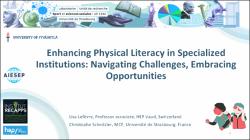Enhancing Physical Literacy in Specialized Institutions: Navigating Challenges and Embracing Opportunities

Type de référence
Date
2024-05-14Langue de la référence
AnglaisRésumé
The introduction of physical activity and the extension of 30 minutes of daily physical activity for the 110,000 children and adolescents in specialized institutions in France is a very recent development. Although physical activity has already found its way into programs in various forms, its sustainability and implementation remain fragile, as evidenced by the IGAS report N°2022-088R on the implementation of daily physical activity in institutions for disabled children in France. To date, very little work has been done on physical activity for young people with disabilities in specialized settings, even though the benefits of PA are considered essential for the development and well-being of young people. The last decade has been marked by emerging work in physical literacy and inclusive education (Agiovlasitis et al., 2018). Yet recent research has shown that understanding of PL (Whitehead, 2019) reflects the normative standards of those without disabilities. This perspective leads to practices that validate ableism (Pushkarenko et al., 2023) and reduce young people's perspectives of choice and singularity. We still need to understand how directors of specialized establishments conceive and facilitate the implementation of sports and artistic practices within their institution. We seek to identify facilitators and challenges. The ability of everyone to embark on their own physical literacy journey is one of the key tenets of physical literacy. However, it can be a daunting task for educators and leaders of institutions who still have a responsibility to create universally accessible physical literacy opportunities to develop or adapt a program to be disability inclusive. In this presentation, in order to paint a picture of the situation and to understand how PA is viewed through the socio-ecological framework (Bauman, 2012), we try to present an initial exploratory study conducted with different directors of specialized institutions in France. Agiovlasitis, S., Yun, J., Jin, J., McCubbin, J. A., & Motl, R. W. (2018). Physical activity promotion for persons experiencing disability: The importance of interdisciplinary research and practice. Adapted physical activity quarterly, 35(4), 437-457. Bauman, A. E., Reis, R. S., Sallis, J. F., Wells, J. C., Loos, R. J., & Martin, B. W. (2012). Correlates of physical activity: why are some people physically active and others not? The Lancet, 380(9838), 258–271. https://doi.org/10.1016/s0140-6736(12)60735-1 Pushkarenko, K., Causgrove Dunn, J., & Goodwin, D. (2023). The Meaning of Physical Literacy for Instruc- tors of Children Experiencing Disability, from an Ecological Systems Perspective. Children, 10(7), 1185. Whitehead, M. (2019) Definition of physical literacy—Development and issues. In Physical Literacy across the World; Whitehead, M., Ed.; Routledge: Abingdon-on-Thames, 8–18. Keywords: Physical activites, specialized establishments, disabilities, physical literacyPublic(s) cible(s)
ChercheursNom de la manifestation
Association Internationale des Écoles Supérieures d'Éducation Physique - Past Meets the FutureDate(s) de la manifestation
13 au 17 mai 2024Ville de la manifestation
JyväskyläPays de la manifestation
FinlandePortée de la manifestation
internationaleURL permanente ORFEE
http://hdl.handle.net/20.500.12162/7570Document(s) associé(s) à la référence
Texte intégral :
Fichier
Accès
Commentaire
Taille
Autre(s) document(s) :
Fichier
Accès
Commentaire
Taille
- Tout ORFEE
- Détail référence



